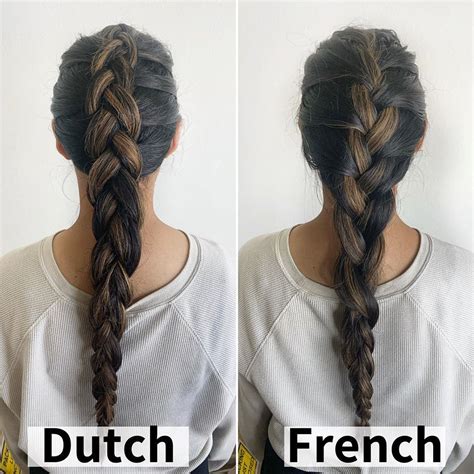Introduction
Braids are a timeless hairstyle that can be worn by people of all ages. They’re versatile and can be dressed up or down. There are many different types of braids, but two of the most popular are Dutch and French braids. Both braids are beautiful and can create a variety of looks, but there are some key differences between them.

Dutch Braids
Dutch braids, also known as inverted braids, are similar to French braids, but they are braided from the bottom up. This creates a raised effect that is visually stunning. Dutch braids are perfect for creating a voluminous look and can be worn in a variety of different ways.
Pros of Dutch Braids:
- Visually stunning
- Creates a voluminous look
- Can be worn in a variety of ways
Cons of Dutch Braids:
- Can be more difficult to master than French braids
- Can be more time-consuming to braid
French Braids
French braids are a classic braiding technique that has been around for centuries. They are braided from the top down and create a smooth, elegant look. French braids are perfect for everyday wear and can be dressed up for special occasions.
Pros of French Braids:
- Classic and elegant
- Smooth and seamless look
- Easy to master
Cons of French Braids:
- Can be less voluminous than Dutch braids
- May not be as versatile as Dutch braids
Which Braid is Right for You?
The best braid for you depends on your personal style and preferences. If you’re looking for a visually stunning braid that will create a voluminous look, then a Dutch braid is a good option. If you prefer a more classic and elegant look, then a French braid is a better choice.
How to Braid: Dutch Braids vs French Braids
Materials
- Rat-tail comb
- Hairbrush
- Hair elastics (optional)
Step-by-Step Instructions for Dutch Braids
- Brush your hair to remove any tangles.
- Divide your hair into three equal sections.
- Cross the right section over the middle section.
- Cross the left section over the new middle section.
- Pick up a small section of hair from the right side and add it to the right section.
- Cross the right section over the middle section.
- Pick up a small section of hair from the left side and add it to the left section.
- Cross the left section over the new middle section.
- Repeat steps 5-8 until you reach the end of your hair.
- Secure the end of the braid with a hair elastic (optional).
Step-by-Step Instructions for French Braids
- Brush your hair to remove any tangles.
- Divide your hair into three equal sections.
- Cross the right section over the middle section.
- Cross the left section over the new middle section.
- Pick up a small section of hair from the right side and add it to the right section.
- Cross the right section over the middle section.
- Cross the left section over the new middle section.
- Pick up a small section of hair from the left side and add it to the left section.
- Cross the left section over the middle section.
- Repeat steps 5-9 until you reach the end of your hair.
- Secure the end of the braid with a hair elastic (optional).
Tips and Tricks
- Use a rat-tail comb to create clean, even sections.
- Keep the tension even as you braid to avoid creating bumps or gaps.
- If you’re having trouble, practice on a friend or family member before trying it on yourself.
- Add hair accessories, such as ribbons or beads, to customize your braid.
Frequently Asked Questions
Q: What’s the difference between a Dutch braid and a French braid?
A: Dutch braids are braided from the bottom up, while French braids are braided from the top down.
Q: Which braid is easier to learn?
A: French braids are generally easier to learn than Dutch braids.
Q: Which braid is more versatile?
A: Dutch braids are more versatile than French braids.
Conclusion
Dutch braids and French braids are both beautiful and versatile hairstyles. The best braid for you depends on your personal style and preferences. If you’re looking for a voluminous and visually stunning braid, then a Dutch braid is a good option. If you prefer a more classic and elegant look, then a French braid is a better choice.
Table 1: Comparison of Dutch Braids and French Braids
| Feature | Dutch Braids | French Braids |
|---|---|---|
| Braiding direction | Bottom up | Top down |
| Volume | More voluminous | Less voluminous |
| Versatility | More versatile | Less versatile |
| Difficulty | More difficult | Easier |
Table 2: Benefits of Dutch Braids
| Benefit | Description |
|---|---|
| Visually stunning | Dutch braids create a raised effect that is visually stunning. |
| Voluminous | Dutch braids create a more voluminous look than French braids. |
| Versatile | Dutch braids can be worn in a variety of different ways. |
Table 3: Benefits of French Braids
| Benefit | Description |
|---|---|
| Classic and elegant | French braids are a classic and elegant hairstyle. |
| Smooth and seamless | French braids create a smooth and seamless look. |
| Easy to master | French braids are easier to master than Dutch braids. |
Table 4: Tips and Tricks for Braiding
| Tip | Description |
|---|---|
| Use a rat-tail comb | A rat-tail comb helps to create clean, even sections. |
| Keep the tension even | Keeping the tension even prevents bumps or gaps from forming. |
| Practice on a friend or family member | If you’re having trouble, practice on a friend or family member before trying it on yourself. |
| Add hair accessories | Hair accessories can customize your braid and make it more unique. |
